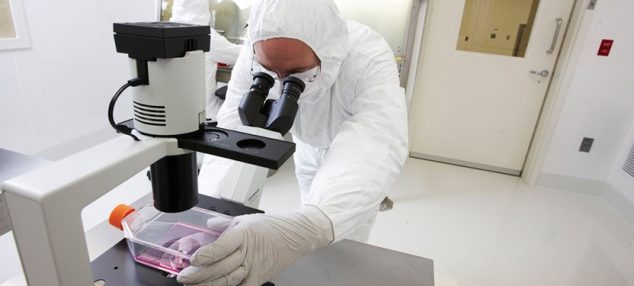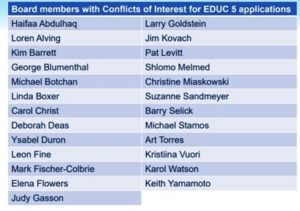News
Stem cell agency lists own board members with conflicts of interest
 A stem cell researcher at UC Davis. (Photo: UC Davis Stem Cell Program.)
A stem cell researcher at UC Davis. (Photo: UC Davis Stem Cell Program.)In a first in its 18-year history, the California stem cell agency has begun posting on its website a list of its governing board members who have conflicts of interest as they award hundreds of millions of dollars.
The most recent example comes next Tuesday in a $48 million round that will benefit at least 16 public and private colleges in the Golden State and up to 400 students at a cost of $58,220 each.
The latest list shows that 25 members of CIRM’s 35-member governing board have conflicts in the round to be considered Tuesday.
The public conflict postings reflect an awareness of the need for transparency at the $12 billion agency, officially known as the California Institute for Regenerative Medicine (CIRM). The research effort was created by voters in 2004 via a ballot initiative, Proposition 71. The measure gave many of the potential beneficiaries a seat at the table where the money is handed out.
Since CIRM’s inception, about 80 percent of its awards — now totaling $3 billion — have gone to institutions that have links to past or current members of its board, according to an analysis by the California Stem Cell Report and Capitol Weekly. CIRM’s former general counsel, James Harrison, once described the situation as a product of “inherent conflicts of interest.”
The latest list shows that 25 members of CIRM’s 35-member governing board have conflicts in the round to be considered Tuesday. The awards involve a new educational program that has a total budget of $58 million. Applicants range from state and private colleges to University of California campuses.
CIRM began the conflict postings in June when they numbered 24. In July, the number stood at 12. (Below is a list of board members with conflicts, according to CIRM.)

Tuesday’s conflict postings are included in a presentation for CIRM board meetings on the applications to be awarded. “It is a good reminder for the board members that they have conflicts with specific applications and that they should check their conflicts sheet before participating in the conversation,” said Kevin McCormack, director of CIRM patient advocacy, in response to a question.
CIRM’s rules state that board members with conflicts cannot vote or speak on applications on which they have a conflict. However, they can remain in the room — whether it involves online or physical space — during the discussion of the applications. Many institutions and government agencies require conflicted board members to leave the room when they have conflicts.
The Academic Review Subcommittee was created in 2013 after the National Academy of Medicine issued a critical, 17-month study that recommended sweeping changes at CIRM.
In Tuesday’s round, the number of board members with conflicts is large because it involves educational programs. Many of the CIRM board members have ties to universities and colleges. The identities of the applicants, however, are withheld by CIRM from both board members and the public until approval of the awards by what is known as the Application Review Subcommittee (ARS). The subcommittee is composed of members of the full board.
The ARS was created in 2013 after the National Academy of Medicine issued a critical, 17-month study that recommended sweeping changes at CIRM. The agency commissioned the study at a cost of $700,000.
“Far too many board members represent organizations that receive CIRM funding or benefit from that funding. These competing personal and professional interests compromise the perceived independence of the ICOC (the CIRM governing board), introduce potential bias into the board’s decision making, and threaten to undermine confidence in the board,” said the academy, then called the Institute of Medicine.
In 2013 in response, the CIRM board created the ARS to publicly approve awards, removing from the process board members most likely to have conflicts. The ARS has only 19 members compared to the 35 on the full board. (In 2013, the board had 29 members.)
Grant applications are reviewed initially by a group of out-of-state scientists who score them and make the de facto decisions on whether they should be funded by the ARS. The ARS and the board have rarely overturned the earlier decisions of the grant application reviewers, who meet behind closed doors and do not publicly disclose their personal, professional or financial interests. The identities of reviewers in a specific round are also not disclosed.
In the case of the posting this month, the list was available online 10 calendar days before Tuesday’s ARS meeting.
This week’s list of conflicts includes all board members with conflicts — not just those on the ARS.
During the discussion of grant applications, members of the ARS have in front of them only the same information that is available to the public — brief review summaries, not the full applications. While the summaries do not identify the applicant by name, their identities can often be ferreted out with an Internet search or by persons familiar with the field.
The appearance on the CIRM website of the conflicts lists began with the June ARS meeting. Like most state agency documents, the lists have always been available to the public. But first, interested persons would have to know that they exist and then ask for them in advance in order to receive them before the meeting in question. In the case of the posting this month, the list was available online 10 calendar days before Tuesday’s ARS meeting.
Brief bios with the affiliations of board members can be found here. Their statements of economic interests, which are required by state law, can be found here.
—
Editor’s Note: David Jensen is a retired newsman. He has written about the stem cell agency since 2005 on his newsletter, the California Stem Cell Report, and is the author of “California’s Great Stem Cell Experiment.”
Want to see more stories like this? Sign up for The Roundup, the free daily newsletter about California politics from the editors of Capitol Weekly. Stay up to date on the news you need to know.
Sign up below, then look for a confirmation email in your inbox.

Leave a Reply